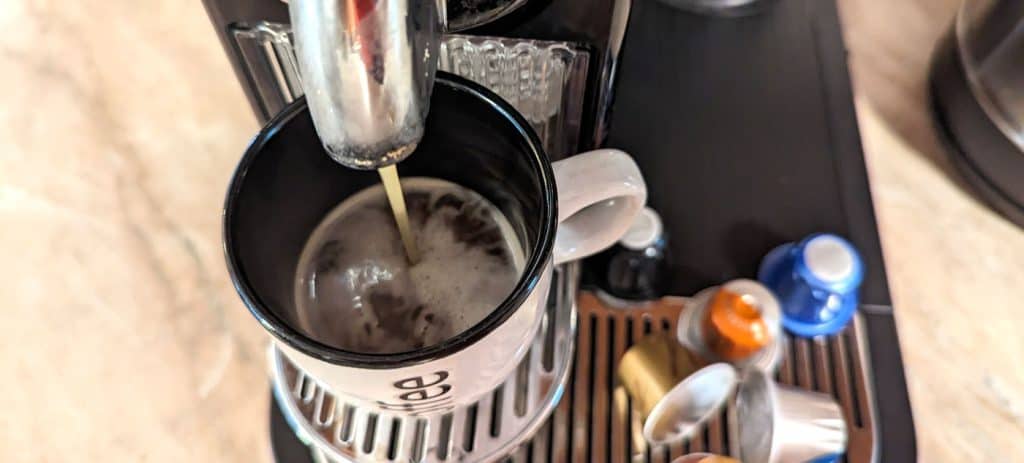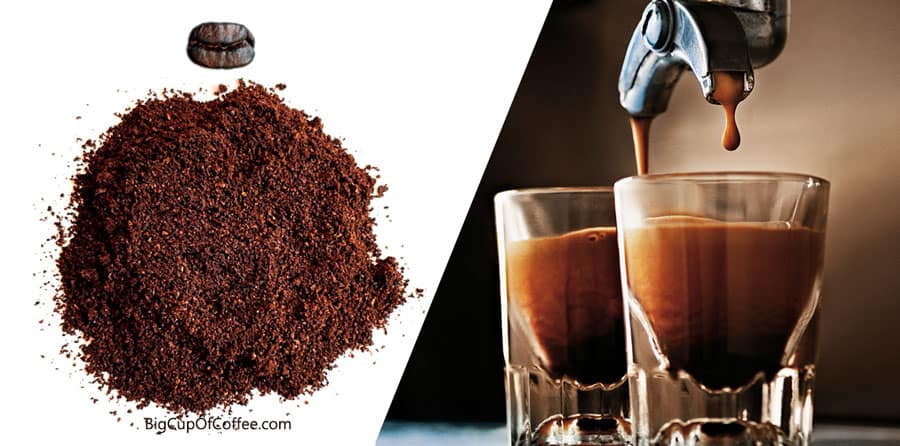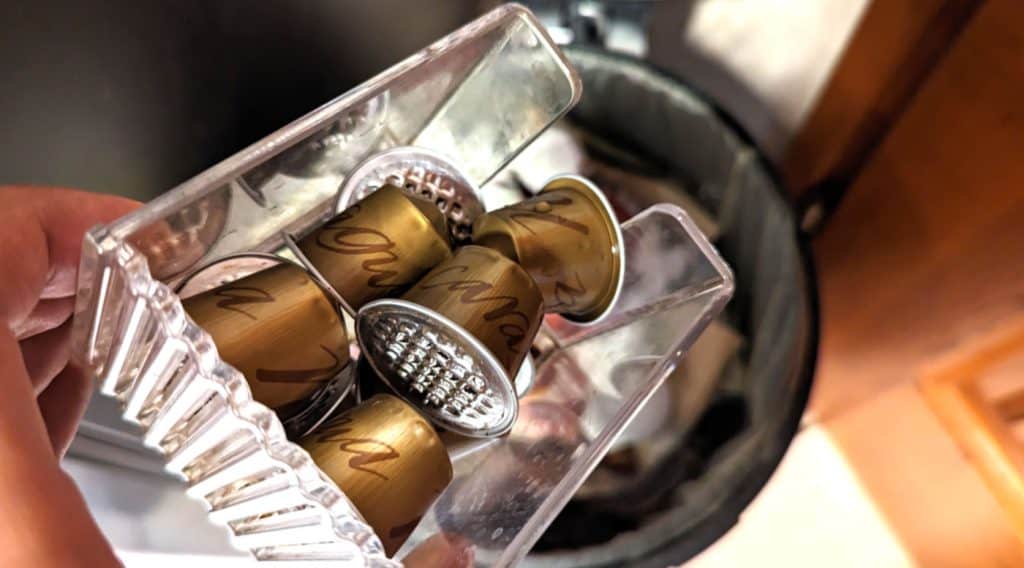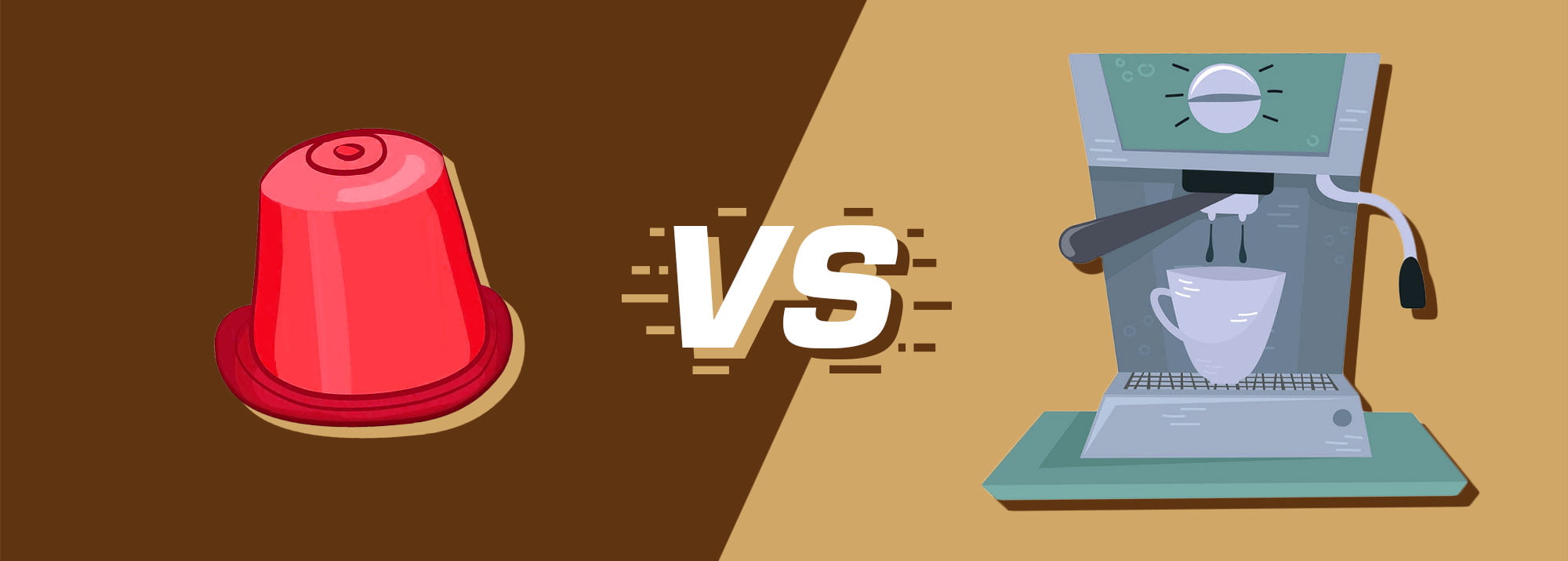Espresso vs Coffee Pods (Nespresso & Keurig) – Pro Barista’s Comparison
When friends are considering buying a home espresso machine, they often ask me which is the better choice between a real espresso machine and a coffee capsule machine like Nespresso.
My answer is never short, since there are different factors to consider when deciding which one really is better.
This is why I’ve decided to write it all down in this in-depth comparison of the espresso and coffee pods.
So if you’re also struggling to choose between these brewers, here’s a helpful guide to help you make an informed decision on which one is better.
Comparing Espresso & Coffee Pods


Espresso is known for its bold and intense brew that packs a punch. The brewing process of an espresso involves forcing hot water through finely-ground coffee at high pressure (9 bars). This results in a concentrated, full-bodied coffee, with the best flavors and oils from the beans and a visually pleasing crema on top. The process of making espresso has been around since the beginning of the 19th century, but 3rd wave coffee has really taken espresso to a new level.
On the other hand, coffee pods such as Nespresso and Keurig K-cups have become popular due to their convenience. These pre-packaged single-serving pods or capsules are inserted into a coffee pod machine. Once punctured, water passes through the pod extracting the coffee inside. They make espresso quickly and easily, but there is always a catch, as I’ll explain in the rest of the article.
Here are the factors to consider when picking between the two brewing methods, followed by a detailed comparison of each feature:
| Features | Espresso | Coffee Pods |
|---|---|---|
| Taste & Flavor | Strong and intense flavor profile with a distinct crema | Various flavor options based on capsule used |
| Strength | Strong | Varied options from mild to extra-strong |
| Ease of Use | Requires practice and skill | Very convenient, little to no effort required |
| Brewing Speed | Takes about 2 minutes | Takes about 1 minute |
| Versatility | Precise brewing method, can alter recipes | Limited control, pre-packaged pods |
| Durability & Portability | Varies based on size and quality | Sturdy, designed for frequent use |
| Sustainability | Home versions are more energy-efficient | Generates a lot of waste |
| Cost | Generally more affordable with no recurring spending on pods | Entry-level models are affordable, but recurring spending on pods is high |
Taste, Flavor, & Strength
Talking about coffee flavor and strength, espresso stands out among all the brewing methods out there. This concentrated coffee has a strong and intense flavor profile with a distinct crema on top of each shot. And to really enjoy its flavors, espresso is often served with sparkling water to cleanse your palate beforehand.
Coffee pods also offer a unique taste experience, which is dependent on the capsule you use. Mind you, some capsules are good, and some are terrible. The good ones tend to cost 3-4x the price of lower-grade capsules though. With various options ranging from mild to extra-strong, you can find a pod suitable for your preference. As for crema, some Nespresso machines create 15 bars of pressure, so the crema forms even better than a traditional espresso maker.
If you’re comparing both brewers with just the flavor and strength alone, then espresso wins over the coffee pods, hands down. Personally, I also prefer this drink because I love the intricate brewing process, not just putting a pod in a machine. But that’s just me.
Ease of Use
Coffee pod machines are far easier to make an espresso with than a proper espresso machine.
Nespresso and Keurig machines require little to no effort to make coffee with, since they use pre-ground coffee stored inside capsules, eliminating the need for any measuring or grinding steps before brewing. Just pop the pod into the machine and press the button.
On the other hand, mastering espresso to dial in a perfect shot requires significant practice and skill. You want precision in every variable, such as the fine grind of coffee and the temperature, which ideally sits within the 190°F to 200°F range.

While espresso is the better brewer in terms of flavor, coffee pods take the win in this category.
If you’re really committed to brewing espresso though, with enough practice you’ll be pulling espresso shots like it’s second nature to you. It is a bit intimidating at first, but you get used to it.
Brewing Speed

For the coffee lover who is always in a rush to get that caffeine kick, both espresso and coffee pods are fast brewing methods. While making an espresso may take you about 2 minutes from prep time to cleaning up, a coffee pod machine brews faster taking only about a minute.
The difference lies in the fact that you have to grind your beans finely and tamp them properly in the portafilter before you can pull your espresso shot. The coffee pods take away these steps with their pre-ground coffee already inside.
When cleaning up, coffee pod machines and home espresso brewers don’t take up much time and effort. For the pod machine, you just wipe down any mess left behind while for the espresso machine, just give the portafilter and basket a quick clean. It is important to note though that both brewers might also require that occasional descaling to keep them in tip-top shape.
So if it’s the speed you’re looking for in a brewer, then opt for the convenience king, the coffee pod machine. But in comparison to the other brewing methods out there, espresso is also a great contender in this race.
Versatility
When brewing, versatility is important because it allows us to experiment with different flavors, strengths, and sizes. Espresso is one of the most precise coffee brewing methods, but key factors such as grind size, dosage, distribution, tamping pressure, water temperature, and extraction time can all affect your resulting cup. You can also alter the espresso recipe to make ristretto and lungo.

In terms of size flexibility though, you can only produce one to two shots of espresso, with each shot equal to an ounce. You can then add volume to your drink by infusing milk or other liquids into your caffeinated drink.
Coffee pod machines offer limited control of the brewing process. You can only choose the pre-packaged pod and choose between 2-3 yield amounts. You can technically stop the water flow sooner, or even lengthen it, but since the capsule has a given amount of coffee ground at a certain size, it cannot compete with dialing in a ristretto or a lungo on an espresso machine.
Overall, espresso is more versatile than coffee pods, but pulling the perfect espresso shot relies on the barista’s skill.
Durability and Portability
When it comes to durability, espresso machines can vary greatly depending on their size and intended use. Commercial-grade models are built with heavy-duty materials that allow them to withstand constant use in a busy café or restaurant setting. However, smaller home models may not be as durable, especially if they are made from cheaper materials.
Coffee pod machines tend to be quite sturdy since they’re designed for frequent use over an extended period of time. If properly cared for, pod machines from well-known brands can last years.
Regarding portability, I don’t recommend either for transport due to their bulky builds since they’re not designed as portable coffee makers. On top of that, both methods require an electric outlet nearby, so it’s best to let them sit on your kitchen countertop and let them do their job as home brewing systems.
Sustainability
Your coffee’s sustainability is vital as it impacts both the environment and our daily lives. Let’s have a look at where espresso and coffee pods stand in terms of eco-conscious concerns.
Espresso machines are known to consume massive amounts of energy which isn’t really eco-friendly. However, the home versions offer an improved solution by using less electricity. For instance, Breville’s (Sage) Barista Pro espresso maker uses ThermoJet technology, which is more energy-efficient since it heats up in just 3 seconds instead of 40 seconds for lower-grade models. This saves you time, and conserves energy.
I would say coffee pods machines are 10x more problematic in this regard. Aside from electricity usage, this method generates significant waste due to its pre-packaged pods’ disposal nature. The majority of consumers also skip recycling these cartridges since most pod recycling programs remain minimal at best. While capsule refill systems exist, they take away the convenience factor associated with coffee pod brewing methods.
You may not know that the inventor of Keurig actually regrets his invention, due to the amount of waste the pods generate.

If you’re choosing a brewing method that leaves less carbon footprint every time you brew, home espresso machines are the better choice by far. But with that said, neither can match these eco-friendly coffee makers.
And remember, you can also make more sustainable decisions such as recycling used coffee grounds or opting for shade-grown coffee.
Cost
Another key factor when buying a brewer is the cost, and unfortunately, neither of these brewers are cheap.
Home espresso machines’ prices can range quite widely depending on the features and quality you’re looking for. You can find some basic models starting under $200, while high-end ones can go up to several thousand dollars.
Coffee pod machines are pricey as well. Entry-level models start at $150, with the high-end models going up to $600. This is cheaper than high-end espresso makers.
Another thing to keep in mind though is that the purchase of pods means recurring spending, which will quickly stack up over time. In 2024, lower-grade pods cost around $0.30, with the brand-name ones starting at around $0.80.
A shot of high-quality espresso beans costs around $0.20, so using an espresso machine is way more economical in the long run, even if a quality model is more expensive at first.
With all things considered, I’ll recommend the espresso machine over the coffee pod machine if you’re wary about the pricing.
Espresso and Coffee Pods – Weighing the Pros & Cons
Now that we’ve gotten a closer look at the features of each brewing method, here’s a quick overview of the pros and cons of espresso and coffee pods so you can finally decide which one is for you:
| Brewing Method | Pros | Cons |
|---|---|---|
| Espresso | – Produces highly-concentrated coffee with crema on top – Very fast to produce – Can be used for numerous recipes | – The espresso machine is not portable – Generally expensive – Requires finely ground coffee beans – Dialing in the espresso requires expertise |
| Coffee Pods | – Automation allows for quick and convenient brewing – Different kinds of pre-packaged capsules for consistent results | – Requires electricity – Pricy plus the pods become recurring expenses – Limited control over the brewing process – Not portable |
You might also want to read about how espresso machines fare in comparison to other brewing methods such as:
I’ve also made comparisons between coffee pod machines and the following brewing methods:
Summary
There you have it, a comparison of the two electric brewing methods that can deliver proper espresso. Declaring which one is better can be tricky since each one of them has its own advantages and drawbacks. If convenience sits on top of your priority list, then choose coffee pods. But if it’s quality and versatility you’re really after, go for normal espresso.
As for me, I’d choose espresso any day over the coffee pods. Nothing really compares to the unique experience coffee pods bring and I just love making cafe-level recipes such as latte, cappuccino, and macchiato. Not to mention the environmental impact of all those capsules…
But that’s just me.
How about you, which brewing method suits you better? Let me know in the comments below.







